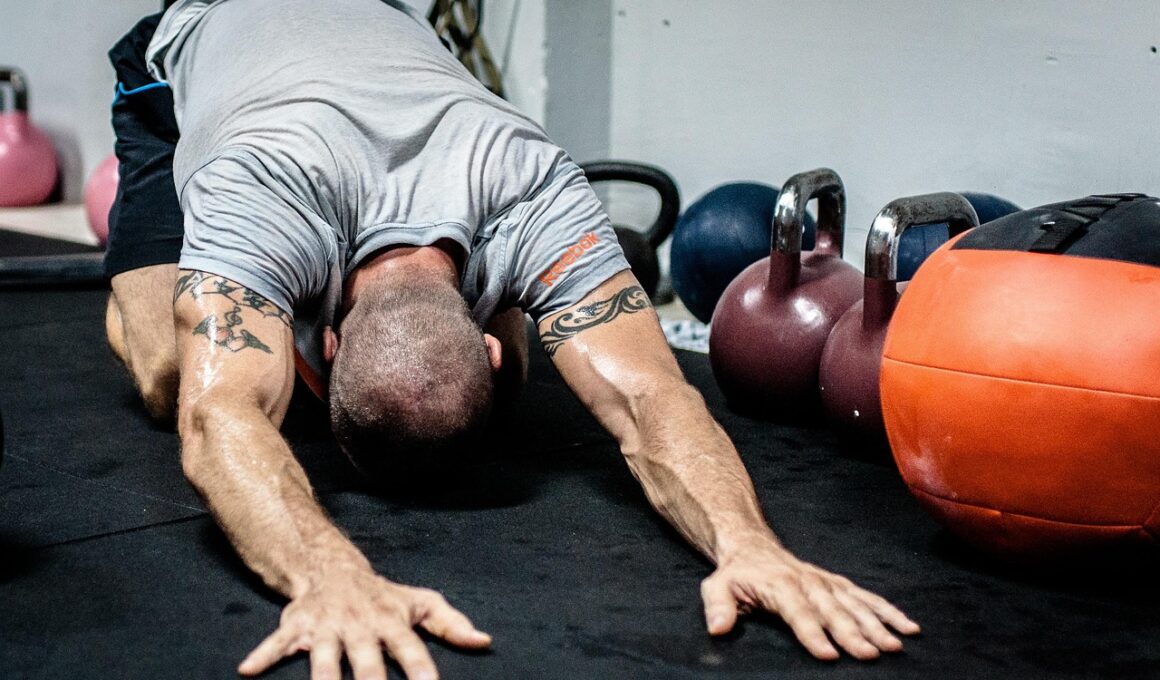Kettlebell Workout Plans Targeting Lower Body Strength
Kettlebell workouts are an excellent way to enhance lower body strength effectively. Incorporating kettlebell training into your fitness regimen can yield impressive results quickly. The primary focus of these workouts is to engage large muscle groups in your legs and glutes, working towards building overall strength and tone. This workout structure allows you to execute compound movements that recruit both primary and secondary muscle groups, maximizing effectiveness. Sessions should ideally begin with a proper warm-up to ensure that your muscles are ready for the strenuous practice ahead. Exercises such as swings, goblet squats, and kettlebell deadlifts significantly target lower body muscles, including the quadriceps, hamstrings, calves, and glutes. With varying weights, practitioners can adjust the intensity as needed. Integrating kettlebells into your workout ensures an engaging session, providing diversity compared to traditional weightlifting. Many individuals find kettlebell training more enjoyable, leading to improved consistency in their workout routines. Careful attention to form is crucial to prevent injuries while maximizing the benefits of the exercises. Therefore, having a structured plan is key for any kettlebell workout aiming for lower body strength.
One effective approach to maximize lower body strength is by executing a kettlebell workout plan that features various exercises targeting the main muscle groups. For instance, incorporating exercises like kettlebell lunges can simultaneously build strength and enhance stability in your legs. You can also explore combining different exercises into a circuit for a condensed yet effective workout. A sample circuit may include the following exercises: kettlebell swings, goblet squats, Romanian deadlifts, and lateral lunges. Each of these movements can be performed for 30 seconds to one minute, followed by a brief rest period. Not only does this challenge your muscles, but it also helps elevate your heart rate, promoting overall health. As you progress, be sure to increase your weights gradually for added resistance. By listening to your body and adjusting your routines, you will begin to notice significant improvements in strength and endurance. Consider incorporating these circuits into your training schedule two to three times a week for optimal results. This consistency is essential in harnessing the full potential of kettlebell workouts in targeting lower body strength.
Key Kettlebell Exercises for Lower Body Strength
When it comes to kettlebell training specifically targeting the lower body, several key exercises should not be overlooked. The kettlebell swing is foundational, as it primarily engages the posterior chain, effectively working the hamstrings and glutes. Additionally, the goblet squat is invaluable in improving lower body strength, enabling individuals to practice their squat form while adding weight. Another excellent movement is the kettlebell deadlift, which further challenges the lower back, hamstrings, and glutes while teaching proper hip hinge mechanics. Lunges, both forward and reverse, can also be dynamically intensified with kettlebells, allowing for greater strength development. Moreover, the sumo deadlift high pull also targets lower body muscles along with incorporating shoulder engagement. Such diverse movements enrich the workout routine while ensuring a comprehensive engagement of the lower body muscles. Correct technique is essential for reaping the full benefits; thus, working with a trainer might be beneficial for beginners. Each exercise can be adjusted based on the weight of the kettlebell and the fitness level of the practitioner, making it universally adaptable.
An effective lower body kettlebell workout plan should cater to both beginners and seasoned athletes. Beginners might start with lighter kettlebells while focusing on mastering the execution of key movements and building endurance. On the other hand, experienced lifters might utilize heavier kettlebells or incorporate advanced variations of standard exercises. It is vital to set realistic goals and establish clear milestones to track progress. Tracking progress will not only enhance motivation but also a sense of accomplishment. You might choose to record your workouts and note any changes in strength and endurance over time. For example, improving the number of reps, duration, or weight used during a rigorous workout can be rewarding. Furthermore, ensuring a balanced approach, including flexibility and mobility training, ensures that you reduce injury risks while enhancing overall fitness. Mixing in some yoga or stretching as part of the active recovery will aid recovery and maintain mobility. The combination of kettlebell training with proper recovery strategies sets the stage for sustainable performance and lasting strength results.
Sample Kettlebell Workout Plan
A sample lower body kettlebell workout plan can greatly help in structuring your fitness routine. Below is an example to help supplement your kettlebell training. Begin with a warm-up focusing on dynamic stretches for about five to ten minutes. Then, proceed with a set of kettlebell swings for 3 sets of 10-15 reps. Follow this with goblet squats, performing 3 sets of 10-12 reps. After that, include kettlebell lunges, alternating legs for 3 sets of 8-10 reps on each side. Next, incorporate kettlebell deadlifts for 3 sets of 10-12 reps. Conclude the workout with a cooldown period, including static stretching focusing on the lower body muscles. This plan should be executed two to three times a week, leaving adequate rest between sessions. This ensures muscles have time to recover and adapt to the training. Listen to your body during this structured plan; adjustments might be necessary based on how you feel during and after each session. Balancing intensity and recovery times is essential for optimum results.
Incorporating kettlebell training into your workout routine can significantly transform your lower body strength over time. However, nutrition plays a critical role in supporting this transformation. Adhering to a balanced diet that focuses on the nutritional needs of an athlete will accelerate desired results. Be sure to consume an adequate amount of protein to aid muscle repair and growth while considering carbohydrates for energy during intense workouts. Healthy fats should not be overlooked as they support overall health. Hydration is also crucial, particularly during and after exercise, to ensure optimal performance and recovery. Consider preparing meals ahead of time to ensure consistency and proper nutrition throughout the week. Meal planning is strategic and essential for success when engaging in a rigorous kettlebell workout regimen. Additionally, being aware of when and what to consume post-workout ensures that your body receives the necessary nutrients to recover efficiently. This holistic approach combining rigorous kettlebell training with targeted nutrition will maximize your lower body strength and overall physical fitness, paving the way toward your fitness goals.
Tracking Your Progress in Kettlebell Training
Finally, tracking your progress in kettlebell training is an essential aspect of any workout plan aimed at improving lower body strength. Utilize a journal or a fitness app to log sets, reps, and weight used during your workouts. This data will help you analyze your growth over time, identifying trends in strength improvements and highlighting areas needing attention. It can also keep you motivated to push through challenging weeks. Take before and after photos every few weeks to visually track your physical changes and celebrate small victories along the way. Consider periodically reassessing your form with a focus on technique. Engaging with the kettlebell community through forums or classes can help you gain insights, additional workout ideas, and support. This can also make training more enjoyable while pushing your limits further together. Evaluating your journey regularly can also point out whether variations in your program may be necessary to avoid plateaus, keeping your workouts fresh. Remember that patience and consistency are fundamental for achieving desired outcomes with kettlebell training for lower body strength.
In conclusion, a well-structured kettlebell workout plan targeting lower body strength will benefit your overall fitness journey. These workouts excel not only in building muscle strength but also in improving your physical endurance and agility. Consider mixing various exercises together for a passion-filled session. Ultimately, finding a balance in implementing such a plan into your regular training can lead to incredible results. Your lower body will thank you for including kettlebell exercises in your routine, helping achieve strength and definition. While these workouts are adaptable, consistency is crucial to reach your long-term fitness goals through kettlebell training.


